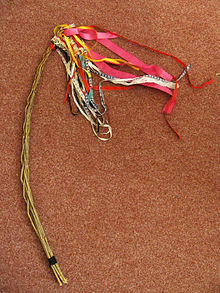Culture of the Czech Republic
| Part of a series on the |
| Culture of the Czech Republic |
|---|
 |
|
| Czech Republic portal |
Czech culture has been shaped by the nation's geographical position in the middle of Europe, the Slavic ethnicity of Czechs, influences from its neighbors, political and social changes, wars and times of peace.
There are 16 Czech locations listed among the World Heritage Sites by UNESCO,[1] six Czechs have been awarded a Nobel Prize[2] and 173 have been nominated.[3]
History
This section needs expansion. You can help by adding to it. (February 2022) |
Architecture

The Czech Republic has been home to many architectural jewels and renowned architects. Peter Parler's contributions to gothic Prague, Benedikt Rejt's late gothic deconstructivistic work, father and son Dietzenhofers' baroque works, Santini's unique baroque style, Fanta's and Polívka's Art Nouveau landmarks of the early 20th century Prague, Rondocubist attempts of Gočár and Janák at creating a distinct national style for the new Czechoslovak Republic – all of these are great examples of the rich architectural tradition of the Czech lands. The Czechoslovak pavilion was awarded the best pavilion of the 1958 World Expo in Brussels, earning the name Brussels style for the Czech architectural styles of those years. Jan Kaplický was a renowned Czech postmodern architect, particularly known for his works in the United Kingdom and one of the best known contemporary Czech architects is Eva Jiřičná, who won the Jane Drew Prize in 2013.[4]
Art

The art tradition in the Czech lands starts with engravings on
One of the most prominent Czech
Cinema

The history of Czech cinema starts with Jan Kříženecký, an early pioneer of cinematography from the end of the 19th century. The first major film studio, Barrandov Studios, was launched by Miloš Havel in 1933.[7] Otakar Vávra was among the most notable domestic directors in Czechoslovakia from the late 1930s onward. In the 1960s – leading up to the Prague Spring of 1968 – the Czechoslovak New Wave emerged, led by directors like Miloš Forman, Věra Chytilová or Jiří Menzel. Miloš Forman managed to flee before the invasion of Czechoslovakia in 1968 and continued his career in the United States, where he reached high critical acclaim and received two Academy Awards for Best Director for his movies One Flew Over the Cuckoo's Nest (1975) and Amadeus (1984).[8] Jiří Menzel was another Academy Award laureate, winning the 1967 Academy Award for Best Foreign Language Film with his first feature film, Closely Watched Trains.[9] A contemporary director Jan Svěrák is another laureate of the Academy Award for Best Foreign Language Film, which he received for his drama Kolya in 1996.[10]
The Czech Republic also has a long tradition in animated movies. Probably the most notable animator is Jiří Trnka – active from 1940s to 1960s – recognized especially for his stop motion puppet movies.
Cuisine and diet
Traditionally, the main meal of the day consists of two courses with the first being a
Among the most common traditional dishes are roasted pork with dumplings and cabbage (vepřo, knedlo, zelo in Czech),
.Folklore and traditions

The most widely celebrated holiday is Christmas, beginning with a dinner on December 24. The traditional Christmas dinner consists of a fried Czech carp and a potato salad, but many people replace it with a chicken or pork schnitzel.
January first is New Year's Day. After a late morning start the main meal of the day is prepared, which should include pork for good luck and lentils for prosperity in the new year. It's bad luck to eat fish, your luck could swim away, or poultry, your luck could fly away.[
Literature
Music
One of the most notable early baroque composers is
Public holidays
Sports
Theatre
Czech theatrical tradition played a big part in the
Museum
See also
- Name days in the Czech Republic
- Flag of the Czech Republic
- National anthem of the Czech Republic
- Prague underground (culture)
- Youth in the Czech Republic
References
- ^ "World Heritage List". UNESCO World Heritage Centre. Retrieved 4 February 2021.
- ^ "All Nobel Prizes". NobelPrize.org. Retrieved 4 February 2021.
- ^ "Nomination Archive". NobelPrize.org. 1 April 2020. Retrieved 4 February 2021.
- ^ Karissa Rosenfield (8 March 2013). "Eva Jiricna Awarded 2013 Jane Drew Prize". ArchDaily. Retrieved 12 January 2014.
- hdl:10810/37322. Retrieved 2 February 2021.
- ^ "Kupkův obraz Divertimento II vytvořil nový český aukční rekord". Novinky.cz. Retrieved 8 February 2021.
- ^ Bawden, Liz-Anne, ed. (1976) The Oxford Companion to Film. London: Oxford University Press; p. 55
- ^ "The Official Academy Awards Database". Retrieved 7 February 2021.
- ^ "The Official Academy Awards Database". Retrieved 7 February 2021.
- ^ "The Official Academy Awards Database". Retrieved 7 February 2021.
- ^ "Czechs pick billions worth of forest mushrooms, berries annually". Radio Prague International. 24 July 2009. Retrieved 7 February 2021.
- ^ "Beer Consumption by Country 2021". worldpopulationreview.com. Retrieved 7 February 2021.
- ^ "Czech Slovak Heritage Tours Holiday and Traditions Page". Czechheritage.net. Archived from the original on 15 August 2017. Retrieved 20 August 2017.
- ISBN 978-0-19-506177-2.
- ^ Cooper, Michael (23 August 2013). "The Deal That Brought Dvorak to New York (Published 2013)". The New York Times. Retrieved 8 February 2021.
- ^ Clapham, John, Dvořák, Norton, New York, 1979, pp. 132–133.
- ^ "Karel Gott: Czech singer dubbed 'Sinatra of the East' dies". BBC News. 2 October 2019. Retrieved 8 February 2021.
- ^ Asimov, Isaac (September 1979). "The Vocabulary of Science Fiction". Asimov's Science Fiction.
External links
- Czech culture Archived 2019-12-02 at the Wayback Machine- Culture of the Czech Republic
- Current Czech events abroad
- Cultural life of the Czech Republic

